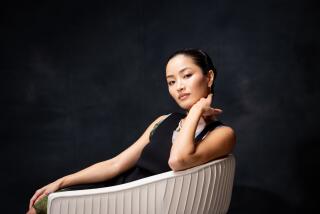A ‘Geisha’ drenched in cherry blossoms
It took Arthur Golden 15 years to research and write “Memoirs of a Geisha,” his bestselling novel set in 1930s and ‘40s Japan. It didn’t take quite that long for the story to make it onto the screen, though the road was long and reportedly bumpy. The casting of Chinese actresses in the principal roles caused some grumbling in Japan, just as the all-Asian cast provoked some anxiety at the studios. Both concerns feel somewhat literal-minded and misplaced, though their double-edged tension could account somewhat for the film’s seeming to unfold in an Orientalist daydream rather than an actual place and time. If the book was celebrated for its meticulous attention to historical detail, the movie’s heart belongs strictly to Hollywood.
Directed by Rob Marshall (“Chicago”) and starring Ziyi Zhang, Michelle Yeoh, Gong Li and Ken Watanabe, the story arrives in a flurry of snow and pink cherry blossoms, swathed in silk and carefully powdered and primped for its march down the red carpet. An extravagant, relentlessly gorgeous melodrama, “Geisha” luxuriates in its own exquisite weepiness, emerging after a long soak as a classic Cinderella story -- a destitute but beautiful young girl named Chiyo (Suzuka Ohgo) survives untold hardship to become Sayuri (Zhang), the most celebrated geisha of her day.
If Golden’s book lingered on the epochal tension of a subculture rooted in tradition at a time when tradition was being blasted away, the movie prefers to keep its eyes trained on the catty rivalries and casual cruelties that make up the life of a geisha-in-training.
Marshall devotes some time to the schooling and rituals, but what really piques his interest are the behind-the-scenes power struggles that leave you with the impression of having watched “Mean Girls” in kimonos.
Details get fudged to conform to Hollywood tropes and standards, so weird-looking chicks, like foreign languages (except for a prologue in Japanese), are out. Gone are the traditional stark white faces, rouged lower lips against white upper lips, shaved eyebrows repainted high on the forehead and matronly bouffants. The geishas have been sexified for Western consumption.
The movie begins with a beautiful young girl named Chiyo being sold to an okiya, or geisha house, by her impoverished fisherman father. The house is run by the crusty, pipe-smoking Mother (Kaori Momoi) and the sweet, motherly Auntie (Tsai Chin), but it’s ruled by Hatsumomo (Li), a geisha-diva as beautiful as she is despised. A teahouse legend, Hatsumomo does not appear to have let the years of geisha training get to her.
At home, she skulks around in various states of dishabille, bed-hair hanging fetchingly over a single eye, snarling at everybody who gets in her way. There’s a reason for the attitude: “It is not for a geisha to love!” we soon learn, but unfortunately for Hatsumomo, she already does. So, naturally, does Chiyo, from the very moment she meets the handsome Chairman (Watanabe) on a bridge and he buys her a treat. But it’s not for a geisha to -- well, you already know.
The beautiful Zhang -- who here possesses a pair of startling blue eyes that have the unfortunate effect of making her look glaucomatous -- may grow up to be a superstar entertainer, but she might as well be listed on the Chicago Mercantile Exchange for the ease with which she’s bought and sold.
Thanks to Hatsumomo’s scheming, she ends up indentured to Mother. She’s then leased by the famous Mameha (Yeoh), another famous geisha with long, flowing hair, a sphinx-y smile and a cunning, sexual-political agenda.
Playing Glinda to Hatsumomo’s Wicked Witch of the East, Mameha decides to help Sayuri take the place of Hatsumomo at Mother’s okiya, so that peace may come to the geishas of Gion. So she gets to work transforming Chiyo into Sayuri, auctioning off her virginity and promoting her as a consort to the gruff and disfigured Nobu (Koji Yakusho).
Rather than explore the tension between the geishas’ public role as highly controlled, highly stylized “ideal women” and their personal desires, Marshall gives us three desperate teahouse “nocturnal wives,” suffering one exquisite torment after another.
A scene in which Sayuri is prepped for her teahouse debut is accompanied by warpath music. Beauty, as we’re continually reminded, is pain.
But then pain is beauty, and as “Geisha” swoons and flutters over every betrayal, near-miss and emotional torture that make up Sayuri’s life, it’s hard not to get swept up in the exquisite torment of it all. Besides, as my viewing companion remarked later, you put all those crazy women in one rice-paper house, emotions are bound to run high.
“Geisha” presents a particularly American view, pitting tradition against self-realization. And it fails to illuminate what the book (as I remember it) seemed to, that geishas enjoyed a freedom and education that other Japanese women did not. In the context of the teahouse, they were able to enjoy a parity with men that was unavailable to wives and daughters.
As central as they are to the geishas’ lives, the men in the film are at best peripheral. “Memoirs” is a woman’s picture in the most old-fashioned Hollywood sense. For all of Mameha’s kindness to Sayuri, she remains an enigmatic figure with an agenda.
Even Sayuri’s innocent friend Pumpkin (Zoe Weizenbaum, and later Youki Kudoh), whose time spent among American soldiers has an unfortunate “Full Metal Jacket” effect on her speech, turns out to have claws. And the set-piece de resistance: a catfight in which Hatsumomo is given free reign to unleash her dormant Glenn Close.
Spanning two decades and a momentous war, “Memoirs of a Geisha” displays all the pomp and grandeur of an epic, but you wouldn’t call it sweeping.
The story plays out in small rooms and smaller realms of possibility. It compensates by ratcheting up the emotion to operatic decibels and playing up the theatrics to the point of absurdity. (Sayuri’s big moment comes when she performs a bizarre avant-garde dance on 10-inch platforms to what sounds like John Cage on the mandolin.)
Strip away the silk and circumstance, and “Memoirs of a Geisha” is a titillating tear-jerker about virtue corrupted and innocence rescued by men of means.
By the time Sayuri asks, “What do we know about entertaining Americans?” you want to say, “Honey, please, you’ve been doing it for two solid hours.”
*
‘Memoirs of a Geisha’
MPAA rating: PG-13 for mature subject matter, some sexual content
Times guidelines: Contains some nudity and sexual situations
Columbia Pictures, DreamWorks Pictures and Spyglass Entertainment present an Amblin Entertainment/Red Wagon Entertainment production. Directed by Rob Marshall. Screenplay by Robin Swicord. Based on the book by Arthur Golden. Produced by Lucy Fisher & Douglas Wick and Steven Spielberg. Director of photography Dione Beebe. Production designer John Myhre. Editor Pietro Scalia. Costume designer Colleen Atwood. Music by John Williams. Cello solos by Yo-Yo Ma. Running time: 2 hours, 24 minutes.
At selected theaters; in wider release next Friday.
More to Read
Only good movies
Get the Indie Focus newsletter, Mark Olsen's weekly guide to the world of cinema.
You may occasionally receive promotional content from the Los Angeles Times.










